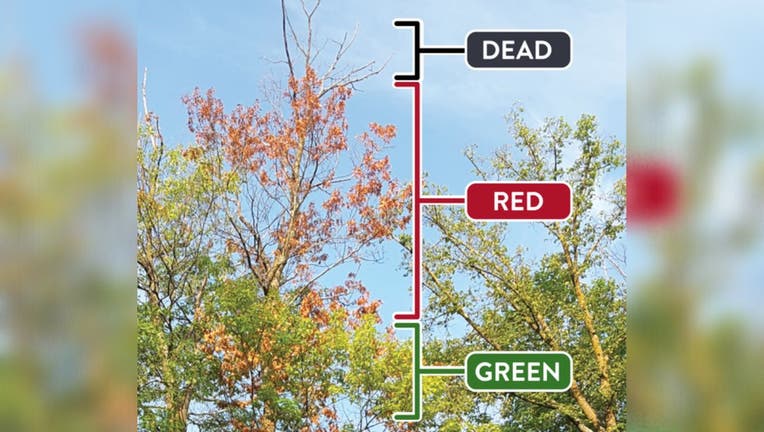Minnesota oak trees showing signs of drought, insect infestation

Oak trees stressed by recent drought have been showing symptoms of infestation by twolined chestnut borer, according to the Minnesota Department of Natural Resources. (Minnesota DNR / Supplied)
(FOX 9) - Oak trees in Minnesota are showing signs they're infested by beetles, which can happen when trees are weakened by drought.
The Minnesota Department of Natural Resources on Thursday said oak trees that have been stressed by the recent drought are showing symptoms of infestation by twolined chestnut borer, a native wood-boring beetle whose larvae feed under the bark of oak trees.
Trees that are weakened by drought are especially vulnerable to these beetles, but healthy trees are usually not infested.
"Even when hot, dry weather is replaced by rainy days, it can take years for trees to recover after a drought," said Val Cervenka, DNR forest health coordinator. "After two consecutive years of drought conditions in 2021 and 2022, we expect to see oak trees dying from twolined chestnut borer attack for the next few years."
Minnesota has been dealing with drought conditions for the past two summers. In 2021, portions of the state saw, for the first time ever, exceptional drought conditions. And drought conditions have persisted this summer.
The latest drought monitor, as of Aug. 30, shows much of the Twin Cities metro is experiencing either severe or moderate drought. Portions of western Minnesota are also seeing abnormally dry to moderate drought conditions. Meanwhile, much of central and northern Minnesota, as well as far southern Minnesota, are not in a drought.
What to look for
The Minnesota DNR says symptoms of a beetle infestation often begin in mid-July and includes dead and dying leaves at the top of the tree, which can stay on branches for months. Then, a year following the attack, the top of the oak tree will be dead and leafless. Leaves in the middle section die, become orange-brown and stay on the tree, while leaves on the bottom will still be green.
If the tree has been infested for more than a year or two, the oak tree may have small D-shaped exit holes in the trunk where the adult borers have come out of the tree, the DNR states.
"Unfortunately, preventing an attack of twolined chestnut borer on stressed oaks is difficult," Cervenka said. "However, you can take steps to reduce stress during drought, which decreases the likelihood of twolined chestnut borer attack."
Forestry officials also say oak wilt and twolined chestnut borer symptoms can look similar. The DNR explains: "Red oaks with oak wilt will rapidly drop most of their leaves within six to eight weeks, and leaves may be green or only partly brown when they fall from the tree. In contrast, dead leaves on trees attacked by twolined chestnut borer will hang on to the tree and remain brown."
What you can do to help your trees
The Minnesota DNR has a few tips to reduce stress for trees in your yard:
- Mulch and water your trees properly. If there hasn't been enough rain, watering oaks weekly may be the best method to prevent twolined chestnut borer attacks.
- Avoid adding soil over roots
- Do not fertilize stressed oaks
- Do not allow herbicides to contact oak leaves
The Minnesota DNR has a website dedicated to forest health with more information.

